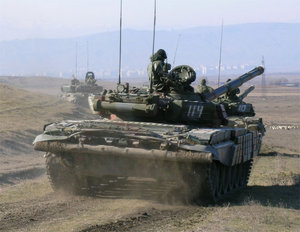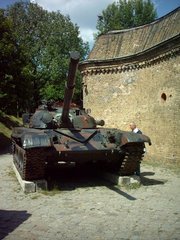T-72
|
|

| |
| General characteristics | |
|---|---|
| Length | 6.9 m |
| Width | 3.6 m |
| Height | 2.2 m |
| Weight | 41 t |
| Speed | 75 km/h (road) 50 km/h (off-road) |
| Range | 450 km |
| Primary armament | 125 mm/L80 gun utilizing electro-hydraulic autoloader with 40 rounds ammunition In late designs 24 rounds 125 mm ammunition and 8 rounds AT-11 "Svir" laser-guided antitank missiles |
| Secondary armament | PKMT 7.62 mm coaxial MG 7.62 mm MG Some variants also have an NSVT or DShK 12.7 mm heavy machine gun in an antiaircraft mount atop the turret, in front of the commander's hatch, others do not. |
| Power plant | 582 kW (780 hp) diesel |
| Crew | 3 (commander, driver and gunner) |
The T-72, a Soviet main battle tank entered production in 1971. It is a parallel design with the T-64. The T-72 design has been further developed as the T-90.
At least some technical documentation on the T-72 is known to have been passed to the CIA by the Polish Colonel Ryszard Kuklinski.
| Contents |
Production history
The T-72 was the most common front-line tank used by the Red Army from the 1970s to the collapse of the Soviet Union. It was also exported to other Warsaw Pact countries and several other countries such as Finland, India, Iran, Iraq and Yugoslavia, as well as being copied, both with and without licenses, in a number of other countries.
The Yugoslavs called their copy the M84, and sold thousands of them around the world during the 1980s. The Iraqis called theirs the Assad Babyl, which means "Lion of Babylon," though the Iraqis assembled theirs from "spare parts" sold to them by the Russians as a means of evading the UN-imposed weapons embargo). More modern derivatives include the Polish PT-91 Twardy and Russian T-90. Russian and Ukrainian industries also offer modernization packages for older T-72s.
Various versions of the T-72 have been in production for decades, and the specifications for its armor have changed considerably. Early T-72 tanks had homogenous cast steel armor incorporated spaced armor technology and were moderately well protected by the standards of the early 1970s. Around 1980, the Soviets began building the tanks with composite armour similar to the Chobham armour used in modern Western tanks, in the front of the turret and the front of the hull. Late in the 1980s, T-72 tanks in Soviet inventory (and many of those elsewhere in the world as well) were fitted with reactive armour tiles. It is believed that since 1985, T-72 tanks in Russian military service have been fitted with laser rangefinders of French design; since 2000, some may have been fitted with thermal imaging night-vision gear of French manufacture as well (though this is less likely than that they might simply use the locally manufactured 'Buran-Catherine' system, which incorporates a locally manufactured version of the French AGAVA-2 thermal sight). Depleted uranium armour-piercing ammunition for the 125 mm gun has been manufactured in Russia in the form of the BM-32 projectile since around 1978, though it has never been deployed, and is less penetrative than the later Tungsten BM-42, and the newer BM-42M, which compares in penetrative ability to the German DM-53. The T-72 with these enhancements and a skilled, motivated, proficient crew is a formidable opponent even by 21st Century standards, though it is not in the same class as the most modern Western designs such as the M1 Abrams.
Therefore it is not uncommon around the world and is found in the armies of many potential enemies of the US and other Western nations. Many Western analysts regard this as worrisome, due to the fact that, at least theoretically, its 125 mm 2A46 main gun is capable of destroying any modern main battle tank in the world today, including the M1 Abrams. On the other hand, on those three occasions when Soviet clients using T-72s have met Western armies that possessed modern main battle tanks—Lebanon in 1982, Kuwait in 1991, and Iraq in 2003—the Syrians and Iraqis were heavily defeated, although this might have more to do with the poor training and low morale of their crews than with any deficiencies in the T-72 itself. It might also be mentioned that the versions these armies fielded were, in either case, at least 30 years out of date at the time, had not been significantly upgraded, were firing inferior ammunition (often with steel penetrators and half-charges of propellant).
Design characteristics
The T-72 exhibits many design features shared with other tank designs of Soviet origin. Some of these are viewed as deficiencies in a straight comparison to NATO tanks, but most are a product of the way these tanks were envisioned to be employed, based on the Soviets' practical experiences in World War II.
Even the most recently produced T-72s are not especially well protected (with the notable exception of the T-72BM); NATO standard 120 mm/L60 guns firing the M829 series depleted uranium APFSDS rounds, or German Tungsten DM-53 can kill it on the first shot from any angle out past two kilometers, and even the older NATO standard 105 mm/L68 can do it at a kilometer or more—at least with depleted uranium ammunition. First generation reactive armour bricks improve protection only slightly from APFSDS, but more so against HEAT ammunition.
The 125 mm 2A46 series main gun is almost as powerful (depending on the ammunition) as the NATO-standard 120 mm/L60 found in many modern Western MBTs (which is to say, highly powerful and highly lethal, at least theoretically capable of destroying any tank in the world today at a kilometer or more), but its rate of fire depends very much on the state of repair of the autoloader, which is necessary due to the extremely small and cramped interior space in the turret, which prevents the addition of a fourth crew member as a loader. This autoloader is based on the autoloader from the T-62 series with mechanical improvements, and is rather slow and prone to malfunctions if not maintained properly. It takes between seven and fifteen seconds to load a new shell into the main gun, during which time the main gun cannot be aimed due to the fact that the autoloader must crank the gun up three degrees above the horizontal in order to depress the breech end of the gun and line it up with the new shell. Even with a laser rangefinder and a ballistic computer final aiming takes at least another three to five seconds. Even with a very proficient, well-trained crew, a tank with such an autoloader in a condition of poor maintenance (uncommon in elite or guards tank regiments) can only fire approximately four aimed shots per minute. In Western tanks with a human loader, the loading process is much faster, only requiring three to five seconds—and the gunner can aim the gun during this process and fire at the target the instant the loader signals readiness. Modern Western tanks can fire twelve to eighteen aimed shots per minute, compared to the four of most Soviet and Russian designs—though, of course, given the smoke and dust on the battlefield, combined with the relatively poor field of view afforded by even the most efficient and modern periscopes or thermal sights, it is generally regarded as unusual for a tank crew to be able to spot four targets in a minute in most tactical situations (though modern sensors such as thermal imaging sights are changing this).
The vast majority of T-72s do not have FLIR thermal imaging sights, though all T-72s (even those exported to the Third World) possess the characteristic (and inferior) 'luna' IR illuminator. Thermal imaging sights are extremely expensive, and the new Russian FLIR system, the 'Buran-Catherine Thermal Imaging Suite' was only introduced recently on the T-80UM tank. Most T-72s found outside the former Soviet Union do not have laser rangefinders. And only the most modern Russian tanks incorporate the ballistic computers that have been found in Western tanks since the mid 1970s.
Finally, all Soviet and Russian tanks designed after the Second World War are designed with relatively limited angles of elevation available for the main gun. This is due to the fact that the low profile of the tank and the correspondingly low turret top cause the breech to contact the top of the turret, inhibiting depression of the gun (this was seen as a reasonable tradeoff for a low profile). The main gun can only be depressed very slightly from the horizontal, only a few degrees—which does not sound significant until you recall that in defensive situations, the hull-down position, with the tank parked just behind the crest of a ridge and just the muzzle of its gun and part of its turret visible to the anticipated target, have been demonstrated to be highly important.
Western tanks have considerably more elevation range and can be parked in a hull-down position with just the gun and a tiny sliver of the turret showing, whereas Soviet designs under most circumstances cannot take up a hull-down position at all because they cannot depress their guns far enough to park behind a ridge and shoot down the hill. In the interest of fairness, the origin of this shortcoming should be noted. The tactical doctrine of the Soviet Union stressed offense over defense in war. Therefore, it was not particularly important to the Soviet designers that their tank be able to take a defensive position for long periods. Contrast this with the Western outlook evident in such tanks as the Leopard 2, the Leclerc, and the M1 Abrams, which were all designed to fight a defensive war against the presumed Soviet invasion of NATO.
Recent CIS export designs, intended to compete with western tanks on the open market, have placed more emphasis on defence and crew survivability. The Ukrainian T-84-120 Oplot and Russian Black Eagle appear to have superior gun depression, as well as armoured blow-out ammunition compartments.
T-72 models have been employed by Algeria, Angola, Armenia, Azerbaijan, Belarus, Bosnia, Bulgaria, Croatia, Czech Republic, Finland, Georgia, Hungary, India, Iran, Iraq, Kazakhstan, Kyrgyzstan, Libya, Poland, Romania, Russia, Slovakia, Syria, Tajikistan, Turkmenistan, Ukraine, Uzbekistan, Yugoslavia, United States (display, tests).
Variants
Missing image T-72M_bok_RB.jpg T-72M1M |
- T-72 - Original version, optical rangefinder.
- T-72A - Added sideskirts, additional armour, laser rangefinder, electronic fire control system, smoke grenade launchers.
- T-72B - Thicker armour, composite armour in front of turret and front of hull.
- T-72BK - Command version of T-72B, recognizable by having multiple radio antennas.
- T-72BV - Early explosive reactive armour added
- T-72BM - Kontakt-5 explosive reactive armour, composite armour in sides of turret as well, AT-11 "Svir" laser-guided antitank missile
- T-72M - Soviet export version, similar to T-72A (built also in Poland and ex-Czechoslovakia)
- T-72M1 - Soviet export version, with thicker armour (built also in Poland and ex-Czechoslovakia)
- M-84 - improved version produced in Yugoslavia, very widely exported
- Lion of Babylon tank - Iraqi-made version
- PT-91 Twardy - a Polish tank based on T-72M1
- T-72MP - modernization package for the T-72 by KMDB in Ukraine, including improved engine, armour, and fire control
- T-72AG - KMDB modernization package, including improved engine, armour, fire control, and main armament
- T-72-120 - KMDB modernization package, including an auto-loaded main gun capable of firing NATO 120 mm ammunition or ATGM
Combat history
- USSR: Afghanistan (1979-1989)
- Iran, Iraq: Iran-Iraq War (1980-1988)
- Syria: 1982 Lebanon War
- Russia: Chechnya (1994-1996, 1999-2002)
- Gulf Wars (1991, 2003)
See also
External links
- T-72 at JED directory (http://www.jedsite.info/tanks/tango-numbers-su/t-72_series/t72-series.html)de:T-72

